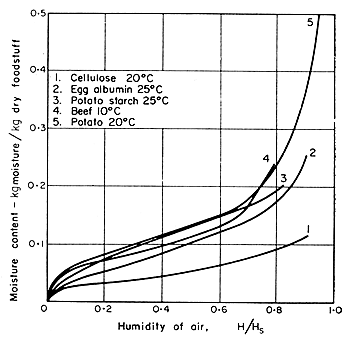CHAPTER
7
DRYING (cont'd)
EQUILIBRIUM
MOISTURE CONTENT
The equilibrium vapour pressure above a food is determined not only by
the temperature but also by the water content of the food, by the
way in which the water is bound in the food, and by the presence
of any constituents soluble in water. Under a given vapour pressure
of water in the surrounding air, a food attains a moisture content
in equilibrium with its surroundings when there is no exchange of
water between the food and its surroundings.
This is called its equilibrium
moisture content.
It is possible, therefore, to plot the equilibrium
vapour pressure against moisture content or to plot the relative
humidity of the air in equilibrium with the food against moisture
content of the food. Often, instead of the relative humidity, the
water activity of the food surface is used. This is the ratio of
the partial pressure of water in the food to the vapour pressure
of water at the same temperature.
The equilibrium curves obtained
vary with different types of foodstuffs and examples are shown in
Fig. 7.4.

